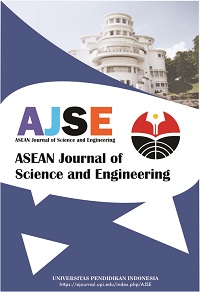Thermal and Mechanical Shock Testing of a Brick Wall and A Polystyrene Wall
Abstract
Keywords
Full Text:
PDFReferences
Abu-Jdayil, B., Mourad, A. H., Hittini, W., Hassan, M., and Hameedi, S. (2019). Traditional, state-of-the-art and renewable thermal building insulation materials: An overview. Construction and Building Materials, 214, 709-735.
Campbell, N., McGrath, T., Nanukuttan, S., and Brown, S. (2017). Monitoring the hygrothermal and ventilation performance of retrofitted clay brick solid wall houses with internal insulation: two UK case studies. Case Studies in Construction Materials, 7, 163-179.
Chand, B., Kaushik, H. B., and Das, S. (2020). Lateral load behavior of connections in Assam-type wooden houses in the Himalayan region of India. Construction and Building Materials, 261, 119904.
Dissanayake, D. M. K. W., Jayasinghe, C., and Jayasinghe, M. T. R. (2017). A comparative embodied energy analysis of a house with recycled expanded polystyrene (EPS) based foam concrete wall panels. Energy and Buildings, 135, 85-94.
Gagg, C. R. (2014). Cement and concrete as an engineering material: An historic appraisal and case study analysis. Engineering Failure Analysis, 40, 114-140.
Kamarou, M., Korob, N., Kwapinski, W., and Romanovski, V. (2021). High-quality gypsum binders based on synthetic calcium sulfate dihydrate produced from industrial waste. Journal of Industrial and Engineering Chemistry, 100, 324-332.
Li, R., Wang, M., and Zhu, J. (2019). Indoor Thermal Environment Monitoring and Evaluation of Double-Deck Prefabricated House in Central China—Taking Zhengzhou Area as an Example. Energy Procedia, 158, 2812-2819.
Masood, R., Lim, J. B., and González, V. A. (2021). Performance of the supply chains for New Zealand prefabricated house-building. Sustainable Cities and Society, 64, 102537.
Naji, S., Aye, L., and Noguchi, M. (2021). Multi-objective optimisations of envelope components for a prefabricated house in six climate zones. Applied Energy, 282, 116012.
Sala, J. M., Lopez-Gonzalez, L. M., de Adana, M. R., Miguez, J. L., Eguia, J., and Flores, I. (2006). Exergetic analysis and thermoeconomic study for a container-housed engine. Applied thermal engineering, 26(16), 1840-1850.
Schieweck, A. (2021). Very volatile organic compounds (VVOC) as emissions from wooden materials and in indoor air of new prefabricated wooden houses. Building and Environment, 190, 107537.
Tanyer, A. M., Tavukcuoglu, A., and Bekboliev, M. (2018). Assessing the airtightness performance of container houses in relation to its effect on energy efficiency. Building and Environment, 134, 59-73.
Trancossi, M., Cannistraro, G., and Pascoa, J. (2020). Thermoelectric and solar heat pump use toward self-sufficient buildings: The case of a container house. Thermal Science and Engineering Progress, 18, 100509.
Utama, N. A., Mclellan, B. C., Gheewala, S. H., and Ishihara, K. N. (2012). Embodied impacts of traditional clay versus modern concrete houses in a tropical regime. Building and Environment, 57, 362-369.
Vestin, A., Säfsten, K., and Löfving, M. (2018). On the way to a smart factory for single-family wooden house builders in Sweden. Procedia Manufacturing, 25, 459-470.
Wyatt, C. L., and Goodman, T. N. (1992). Research note: The utilization of recycled sheetrock (refined gypsum) as a litter material for broiler houses. Poultry Science, 71(9), 1572-1576.
DOI: https://doi.org/10.17509/ajse.v3i1.42788
Refbacks
- There are currently no refbacks.
Copyright (c) 2022 Universitas Pendidikan Indonesia

This work is licensed under a Creative Commons Attribution-ShareAlike 4.0 International License.












